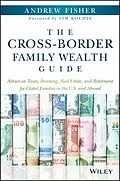Make sense of international personal finance with expat-specific expert advice
The Cross-Border Family Wealth Guide is the long-awaited financial handbook for cross border families, with expert insight from a financial advisor who specializes in expat issues. Whether you're an American living abroad, or foreign-born and living in the U.S., this book demystifies the complex issues surrounding the worldwide tax system, international information reporting, sensible investments, international real estate, and retirement planning. When your wealth crosses international borders, managing even the most mundane financial affairs can become wrought with time-consuming complexity; moving money, opening accounts, dealing with currency risks and translation, and setting up investments suddenly involves a whole new set of rules and regulations. Your 401(k), IRA, or annuity must be handled properly to retain certain tax benefits, and retirement planning takes on a brand new dimension of difficulty. This book shows you how to navigate the maze to make sure your money keeps working for you. Real world examples illustrate solutions to common problems, and real, actionable advice gives you a solid plan for your next steps.
While personal finance management is rarely simple, the recent crackdown on tax havens and increased tax collection vigilance has made things even more difficult for cross border families. This book answers your questions, and shines a light on the way forward to long-term financial security for international families.
* Navigate the complexities of international taxation
* Get specific guidance on retirement planning
* Make sense of how real estate fits into your financial picture
* Invest appropriately to maximize growth for the future
* Manage your assets and tax benefits across borders
With the right know-how, cross border professionals can make sensible investment and financial planning decisions, but credible guidance is rare and difficult to find. Simple and practical, with targeted advice, The Cross-Border Family Wealth Guide is the international family's solution for avoiding financial confusion.
Autorentext
ANDREW FISHER is widely regarded as a leading wealth advisor to cross-border families. He frequently writes and speaks to the unique financial planning and investment complexities faced by international families, particularly when an individual is a tax resident of the United States. Andrew holds the CFA and CPA designations, and serves as president and founder of Worldview Wealth Advisors, an independent wealth management firm focused on financial planning and investment advice for cross-border families.
Inhalt
Foreword by Tim Kochis, JD, MBA, CFP® xvii
Preface xix
Acknowledgments xxiii
About the Author xxv
Part I: Financial Challenges of a Cross-Border Life 1
Chapter 1 Who Are These Cross-Border Families? 3
The Growing Need for a Definitive Guide 4
Who's Who: Who This Book Is Meant to Serve 6
Examples of Who Might Benefit from This Book 7
Diagramming a Cross-Border Person: Residency and U.S. Income Tax Status 8
How Many Cross-Border Professionals and Families Are There? 10
Unique Challenges Faced by Cross-Border Families Connected to the United States 11
Chapter 2 Unique Challenges and the Regulatory Landscape 12
The Unequal Nature of Tax Regimes and Reach 12
The Unique Worldwide Reach of the U.S. Tax System 13
Complexity in Taxation and Other Regulations 14
Scarcity of Professional Help and Information 15
A Changing Legal, Financial, and Regulatory Landscape 17
The Far Reach of the Foreign Account Tax Compliance Act (FATCA) 19
Recommending Against Secretive Offshore Wealth Strategies 20
Part II: Saving and Investing: Building Your Personal Net Worth 21
Chapter 3 Building a Strong Foundation 23
Retirement Destination Unknown: Invest Globally 23
Spreading It Around 24
Wealth Creation and Accumulation 25
Saving from Earnings 25
Real Estate Ownership 26
Stock-Based Compensation 27
Entrepreneurs and Businesses Ownership 27
Investment Gains and Reinvestment 28
Inheritance 28
Diversification: Protecting and Growing Wealth 28
Considering Your Entire Balance Sheet 29
The Meaning of Diversification versus Asset Allocation 30
Spreading Thing Around 30
Asset Allocation in Investment Portfolios 30
A Well-Allocated Portfolio Can Still Lack Diversification 32
Allocating Your Net Worth: A Balance Sheet Approach 32
Six Primary Asset Categories 33
Three Additional Items of Importance 33
Cash and Cash Equivalents 33
Personal Residences 34
Income Property 35
Publicly Traded Securities: Stocks and Bonds 36
Bonds and Bond Funds (Fixed Income) 36
Stocks and Stock Funds (Equities) 37
Downsides of Owning Stocks 38
Concentrated Business Ownership 39
Personal Debt 40
Collectibles and Other Hard Assets 41
Other Private Investment Vehicles 41
Conclusion 42
Chapter 4 Investing in the Markets: Stocks and Bonds 43
Three Important Attributes 43
Easy Diversification 43
No Active Involvement 43
Source of Growth and Risk Control 44
Stocks and Bonds Work Better Together 44
Setting a Risk Objective 45
Managing Emotions While Focusing on the Long Term 45
Stock PickingMaybe Not 46
Investment Advice to Live By 47
Avoiding the Herd Mentality 48
Staying Calm in Times of Change 49
Determining Investment Goals and Objectives 49
Four Common Investor Objectives Defined 50
Fundamental Investment Guidelines 51
Low-Cost Passive Investing 52
Tax Efficiency Is Huge 53
Global Diversification for All 53
Risk Control Through Asset Allocation 54
Regular Rebalancing Adds Value: Don't Invest and Forget 54
Strategic Versus Tactical Asset Allocation 55
Strategic Asset Allocation (SAA) 55
Tactical Asset Allocation (TAA) 55
Take It Slow 56
A Jurisdictional Review: Where to Hold Investments? 57
Large Foreign Banks in Europe or Asia 58
Have You Earned Your Own Private Banker? 58
Not World-Class Investments 58
Not World-Class Advice 59
Tax Reporting and FATCA 59
Large Offshore Private Banks 60
Smaller...
